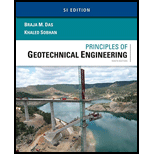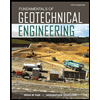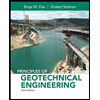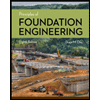
Principles Of Geotechnical Engineering, Si Edition
9th Edition
ISBN: 9781305970953
Author: Braja M. Das, Khaled Sobhan
Publisher: Cengage Learning
expand_more
expand_more
format_list_bulleted
Concept explainers
Question
Chapter 7, Problem 7.21P
To determine
Find the ratio of equivalent permeability
Expert Solution & Answer
Trending nowThis is a popular solution!

Students have asked these similar questions
Existing Filter Design Parameters at 22.5 MGD:
A) # of Filters: 5
B) #Bays per Filter: 1
C) Bay Surface Dimensions (L X W X D): (40.5 ft. X 13 ft. X 11.5 ft.)
D) Surface Area per Filter: 526.5 ft^2
E) Total Filtration Area: 2,633 ft^2
F) Hydraulic Loading Rate: 6 gpm/sf (w/ all filters in service)
G) Filtration Capacity at HLR: 22.7 MGD
H) Filter Media:
1) Anthracite: 20 in. depth, 1.00 mm Effective Size
2) Sand: 9 in. depth, 0.50 mm Effective Size
1) L/d Ratio (depth of media/effective size): 965
J) Backwash Pumps: 15 MGD (two pumps)
K) Backwash water for the filters is provided from the high service pump
station through a 24-inch backwash water
L) Air Wash Blowers:
1) Number: 2 Hoffman Centrifugal Model 38406A, 125 hp
2) Capacity: 3,100 scfm (standard cubic ft/^2)
3) Air Scour Rate: 5.90 scfm/ft^2
Deliverables:
1) Determine if the existing filtration system is sufficient to accommodate the
projected future capacity.
A) Current Capacity: 22.5 MGD
B) Future Capacity: 34.5 MGD for…
Part 1: True or False. Indicate whether the following statements are True (T) or False (F) by encircling
the letter that corresponds to your answer.
1. (T/F) Residual soils are formed by the weathering of rocks in place.
2. (T/F) The Standard Penetration Test (SPT) provides a disturbed soil sample.
3. (T/F) The groundwater table has no effect on the interpretation of soil exploration data.
4. (T/F) Geophysical methods are always more accurate than direct soil sampling methods.
5. (T/F) The N-value in the SPT is the number of blows required to drive the sampler the first 150
mm.
Part 2: Multiple choice. Choose the best answer for each question.
1. Which of the following is NOT a transported soil deposit?
a) Alluvial
b) Glacial
c) Residual
d) Aeolian
2. What is the primary purpose of subsurface exploration?
a) To determine the depth of bedrock
b) To identify soil types and their properties
3. Which test provides a continuous profile of soil
a) Standard Penetration Test (SPT)
b) Cone…
Determin the shear and moment in teh beam as a function of x where 2m<x<4m.
Chapter 7 Solutions
Principles Of Geotechnical Engineering, Si Edition
Ch. 7 - Prob. 7.1PCh. 7 - Prob. 7.2PCh. 7 - Prob. 7.3PCh. 7 - Prob. 7.4PCh. 7 - Prob. 7.5PCh. 7 - Prob. 7.6PCh. 7 - Prob. 7.7PCh. 7 - Prob. 7.8PCh. 7 - Prob. 7.9PCh. 7 - Prob. 7.10P
Ch. 7 - Prob. 7.11PCh. 7 - Prob. 7.12PCh. 7 - Prob. 7.13PCh. 7 - Prob. 7.14PCh. 7 - Prob. 7.15PCh. 7 - Prob. 7.16PCh. 7 - Prob. 7.17PCh. 7 - Prob. 7.18PCh. 7 - Prob. 7.19PCh. 7 - Prob. 7.20PCh. 7 - Prob. 7.21PCh. 7 - Refer to Figure 7.24. The following data were...Ch. 7 - Prob. 7.23PCh. 7 - Prob. 7.1CTP
Knowledge Booster
Learn more about
Need a deep-dive on the concept behind this application? Look no further. Learn more about this topic, civil-engineering and related others by exploring similar questions and additional content below.Similar questions
- Encuentra las fuerzas internas de todos los elementos en las siguientes armaduras por el método de nodosarrow_forwardGiven a side slope of 2:1, a road width of 10 m and cross-sectional area of 36.4 sq m, for the following cross-sectional notes: 9.8..........0...........x2 y1..........y..........1.2 Determine the value of y.arrow_forwardFrom station A with center height for 1.4m in fill, the ground makes a uniform slope of 5% to station B whose center height is 2.8 m in cut. Assuming both sections to be level sections having a width of roadway of 14 m and a side slope of 2:1 for both cut and fill, compute the cross-sectional area of fill 48 m from station A. Distance from station A to station B is 60 m.arrow_forward
- From station 10+100 with center heights of 2 m in fill, the ground line makes a uniform slope of 4.8% to station 10+150 whose center heights is 1.2 m in cut. 1. Determine the slope of a new roadway to be constructed. 2. Determine the distance from station 10+150, will the excavation extend. 3. Determine the area of fill 10 m from 10+100 if the width of roadway is 8 m and the side slope is 1:2.arrow_forwardFunding Plan How much funds required to reach to the next level of the venture? • ? How much have been bootstrapped? If not, why? • ? How much can be bootstrapped? • ? How much external funding required? If not, why? • ? Funds utilization strategy (Details) • ? • ? • ? • ? • ? • ? • • ? ? ? ? ? Place your logo herearrow_forwardA semicircular 40 ft diameter− − tunnel is to be built under a150 ft deep− − , 800 ft long− − lake, as shown below. a) Determine the horizontal, vertical, and resulting hydrostatic forces acting on this tunnel. (Answer: 8 8 8 1.398 10 , 2.596 10 , 2.64 10H y netF lbf F lbf F lbf= × = × = × ) b) Calculate the hydrostatic force on the bottom of the lake if the tunnel was not there, and compare it with the total (resulting) hydrostatic force that you calculated in part (a). (Answer: 8 2.995 10VF lbf= × ) c) As the design engineer of this tunnel would you take the hydrostatic force on the bottom of the lake as a rough estimate of the resulting hydrostatic force acting on this tunnel. Discuss your decision.arrow_forward
- 3.2 Consi parabolic equation (Eq. 3.1) 3.3 Again consider Example 3.4. Does this curve provide sufficient stopping sight distance for a speed of 60 mi/h? -tangent grade with a -1% final mi/h. The station of the 1203 ft. What is the elev 3.4 An equal-tangent crest vertical curve is designed for 70 mi/h. The high point is at elevation 1011.4 ft. The initial grade is +2% and the final grade is -1%. What is the elevation of the PVT? +00? 3.10 An equal-tangent w 2012 (to 2011 AASHTO of 70 mi/h to connec -2.1%. The curve is design speed in th technology has adv design deceleration value used to dev percentage of ol design reaction vehicles have b height is assun roadway obje 3.5 An equal-tangent crest curve has been designed for 70 mi/h to connect a +2% initial grade and a -1% final grade for a new vehicle that has a 3 ft driver's eye height; the curve was designed to avoid an object that is 1 ft high. Standard practical stopping distance design was used but, unlike current design standards,…arrow_forwardFactor of Safety Activity The lap joint is connected by three 20-mm diameter rivets. Assuming that the applied allowable load, P=50kN is distributed equally among the three rivets and a factor of safety of 1.5, find: (a) the failure shear stress in a rivet, and (b) failure bearing stress between the plate and rivet 25 mm 25 mmarrow_forwardDraw the shear and moment diagrams of the beam CDE showing all calculations. Assume the support at A is a roller and B is a pin. There are fixed connected joints at D and E. Assume P equals 9.6 and w equals 0.36arrow_forward
- Find the length of the diagonal on the x-z plane (square root of square of sides). Find angle between the vector F and its projection on x-z (the diagonal defined above). Find Horizontal Projection of F on x-z plane, Fh, and vertical component, FY. Find projections of Fh, to define in-plane components Fx and Fz. Show that results match those of Problem 2(a) above. (2,0,4) F₂ 100 N (5, 1, 1)arrow_forwardFor the control system Draw Nyquist Plot with Solution G(S)= 63.625 (S+1)(S+3) S(S+2)(5+65+18) (5+5)arrow_forwardQ3: Find the support reactions at A: y mm A P=last 2 student's ID#+100 (N) 124N last 3 student's ID# (mm) 724mm 20 mm D B C X last 3 student's ID#+20 mm 744mm 40 mm 60 mmarrow_forward
arrow_back_ios
SEE MORE QUESTIONS
arrow_forward_ios
Recommended textbooks for you
 Principles of Foundation Engineering (MindTap Cou...Civil EngineeringISBN:9781337705028Author:Braja M. Das, Nagaratnam SivakuganPublisher:Cengage Learning
Principles of Foundation Engineering (MindTap Cou...Civil EngineeringISBN:9781337705028Author:Braja M. Das, Nagaratnam SivakuganPublisher:Cengage Learning Fundamentals of Geotechnical Engineering (MindTap...Civil EngineeringISBN:9781305635180Author:Braja M. Das, Nagaratnam SivakuganPublisher:Cengage Learning
Fundamentals of Geotechnical Engineering (MindTap...Civil EngineeringISBN:9781305635180Author:Braja M. Das, Nagaratnam SivakuganPublisher:Cengage Learning Principles of Geotechnical Engineering (MindTap C...Civil EngineeringISBN:9781305970939Author:Braja M. Das, Khaled SobhanPublisher:Cengage Learning
Principles of Geotechnical Engineering (MindTap C...Civil EngineeringISBN:9781305970939Author:Braja M. Das, Khaled SobhanPublisher:Cengage Learning Principles of Foundation Engineering (MindTap Cou...Civil EngineeringISBN:9781305081550Author:Braja M. DasPublisher:Cengage Learning
Principles of Foundation Engineering (MindTap Cou...Civil EngineeringISBN:9781305081550Author:Braja M. DasPublisher:Cengage Learning

Principles of Foundation Engineering (MindTap Cou...
Civil Engineering
ISBN:9781337705028
Author:Braja M. Das, Nagaratnam Sivakugan
Publisher:Cengage Learning

Fundamentals of Geotechnical Engineering (MindTap...
Civil Engineering
ISBN:9781305635180
Author:Braja M. Das, Nagaratnam Sivakugan
Publisher:Cengage Learning

Principles of Geotechnical Engineering (MindTap C...
Civil Engineering
ISBN:9781305970939
Author:Braja M. Das, Khaled Sobhan
Publisher:Cengage Learning

Principles of Foundation Engineering (MindTap Cou...
Civil Engineering
ISBN:9781305081550
Author:Braja M. Das
Publisher:Cengage Learning